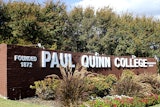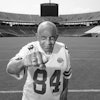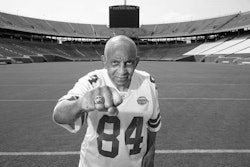Historian Sees Chamberlain as Playing Role in Race Relations
LAWRENCE, Kan.
Taking another look at Wilt Chamberlain, a dominating force in college basketball when he played for the University of Kansas in the mid-1950s, a historian views him as a pivotal figure in both sports and race relations.
Chamberlain, a 7-foot-1 high school star from Philadelphia, was recruited to Kansas in 1955 by coach Phog Allen. He scored 42 points in his first game as the freshman team beat the varsity. Because freshmen couldn’t play on varsity teams in that era, Chamberlain’s official debut with the Jayhawks came the following season.
He had 52 points — still a Kansas record — and 31 rebounds in his first game, and the Jayhawks finished 24-3, losing the national championship to North Carolina by a single point in three overtimes. After a junior year in which he averaged 30.1 points a game, Chamberlain passed up a final season at Kansas to turn pro.
He spent a year with the Harlem Globetrotters before switching to the NBA, where he had 31,419 points over 14 seasons and once scored 100 points in a game for the Philadelphia Warriors.
Aram Goudsouzian, a historian from the University of Memphis, reviews Chamberlain’s time at Kansas in a cover article in the latest issue of Kansas History, a publication of the Kansas State Historical Society.
Beyond the skills which made him “the first real, Black celebrity star in college basketball,” Goudsouzian said, Chamberlain helped effect racial desegregation in Lawrence.
“His size, ability and race threatened the established patterns of college basketball,” the historian told the Lawrence Journal-World, adding that Chamberlain “foreshadowed the changing landscapes of American sports and race relations.”
Chamberlain’s presence and influence, Goudsouzian said, planted seeds of doubt about de facto segregation in Lawrence among some of the community’s leaders.
“It’s complicated,” he said. “It wasn’t that he a) had no effect or b) that he integrated Lawrence. It was somewhere in between. And what he did was on more of a personal level rather than as a barrier-breaker or a symbol of a political movement.”
“He was the most pre-eminent symbol of racial change in Kansas from the late 1950s and into the 1960s,” Goudsouzian said. “If one man embodied the power to change racial attitudes at that time, he was it.”
Jesse Milan, one of the first Black teachers in the Lawrence public schools, also knew Chamberlain but doesn’t see him as having a major role in bringing about change.
“When you go back and look at how Blacks couldn’t buy a house outside of certain neighborhoods, that there weren’t any Black clerks — not a single bank in Lawrence had a Black clerk — that businesses all over town wouldn’t serve Blacks; Wilt Chamberlain didn’t change any of that,” said Milan, who at the time headed the Douglas County chapter of the National Association for the Advancement of Colored People.
“Wilt Chamberlain was not an agent of change,” Milan said. “He was an instrument of his own convictions. I don’t mean that in a critical way. I’m just saying the focus shouldn’t be on him when there were so many unheralded heroes who did so much more.”
Less than two years before his death at 63, Chamberlain, wearing his old Kansas letter jacket, made an emotional return to Allen Field House for a ceremony retiring his jersey number.
“I’ve learned in life that you have to take the bitter with the sweet, and how sweet this is,” he said. “I’m a Jayhawk and I’m proud to be a part of the tradition here. I’m very proud to be here.”
- Associated Press
© Copyright 2005 by DiverseEducation.com


















